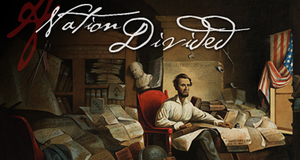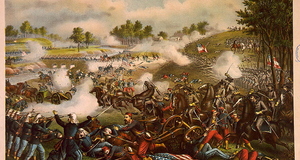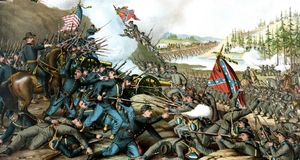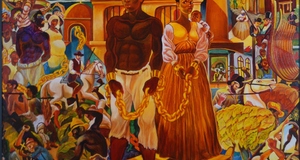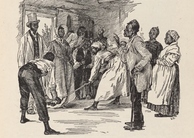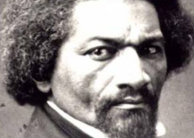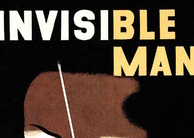Featured Article:The "Roving Ambassador:" Bayard Rustin's Quaker Cosmopolitanism and the Civil Rights MovementEarly Seeds of Resistance"My activism," wrote Rustin near the end of his life, "did not spring from being black. Rather, it is rooted fundamentally in my Quaker upbringing and the values instilled in me by the grandparents who reared me" (19). Moreover, he commented: "Those values were based on the concept of a single human family and the belief that all members of that family are equal [. . .] The racial justice that was present in [America] during my youth was a challenge to my belief in the oneness of humanity" (19). Interestingly, Rustin articulates a notion of cosmopolitanism, or the philosophical worldview that understands all people to be citizens of an inclusive global community, united under common moral law. We can clarify the complexity of this term by referencing the German philosopher Immanuel Kant, who develops a cosmopolitan morality based on what he has termed the Weltbürger, or "citizen of the world" (Louden 161). Similar to Quaker ideals of 'unity' and universal 'oneness,' Kantian scholar Robert B. Louden states that the Weltbürger's "primary allegiance is to the world as a whole, not to any nation or region within it" (161). Thus, Kant's Weltbürger is crucial to understanding how Rustin's activism moved beyond national (American) borders to politically engage other liberation movements both home and abroad. Turning from his childhood, this section focuses on Quaker cosmopolitanism in Rustin's early political activism, particularly his involvement with urban communism and experiences as a conscientious objector. In this way, Rustin's political sentiments, enriched by the language of nonviolence, maps a kind of liberal Quaker philosophy. It is useful to revisit Rustin's early experiences in social activism in order to trace the development of his politics during the civil rights movement. Rustin's earliest affiliations with communism began on a trip to Philadelphia, Pennsylvania, while he was looking for political volunteer work. Rustin was impressed by communist "soapbox orators" who were admonishing black auditors to join in their cause in combating racial inequalities (56). Surely, these charismatic speakers reminded him of the zealous and emotive sermonizing of West Chester's AME church. Rustin admired the communist movement for both its "progressive stance on issues of racial justice" and its message of cosmopolitan inclusivity (55). Significantly, Rustin's initial encounter with the urban communists occurred shortly after the events of the Scottsboro case. The communists were the first group to spearhead an organized budget that would finance the legal defense of the nine black men who had been falsely accused of raping two white women on a freight train passing through Scottsboro, Alabama (Anderson 46). The national outrage provoked by the case galvanized the communist message and allured African-American youth, like Rustin, to participate on the front lines of radical political activism. On a deeper level, however, what attracted Rustin to communism was its status as a predominately white political organization that served as the mouthpiece for voiceless African-Americans. As he expressed in 1941, "The communists were passionately involved and I was passionately involved. So they were ready made for me" (55). For Rustin, communist and Quaker principles seemed compatible in the civil rights struggle as both promised to achieve the social progress needed to dismantle the legal machinery of Jim Crow. 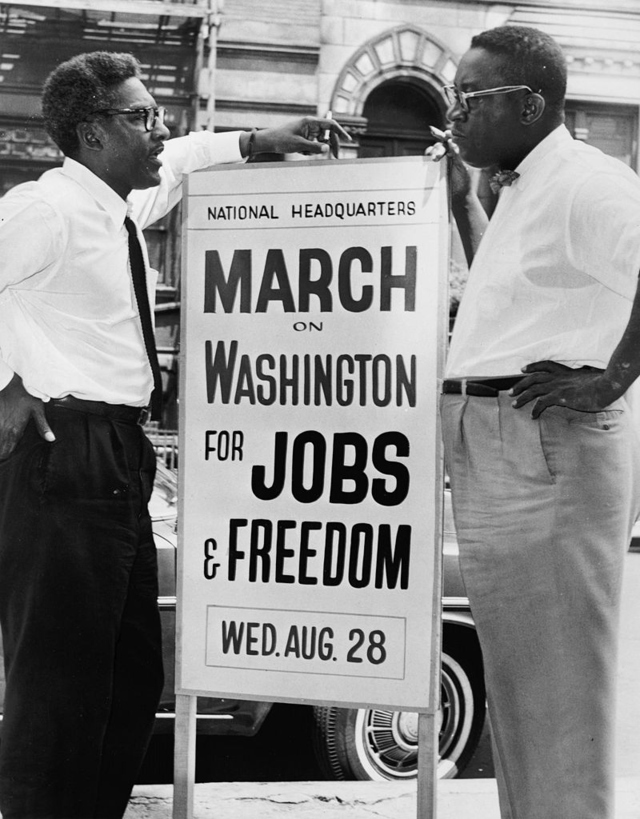
Rustin and Cleveland Robinson on August 7, 1963, prior to the March on Washington for Jobs and Freedom that followed on August 28th. [. . .] The radicals ranged from right-wing Socialists [. . .] to splinters from the Trotskyist left wing. In between was a bewildering variety -- Austro-Marxists, orthodox communists, Socialist centrists, and Socialist left-wingers [. . .] We also had in our midst philosophical anarchists, supporters of the IWW, and all kinds of sympathizers, fellow-travelers, and indeterminists. (53) Indeed, Rustin was at the center of a heady brew of radical ideologies, clashing political sentiments and progressive attitudes; however, despite this dizzying array of thought, Rustin maintained a firm grip on Quaker philosophy and saw an emerging compatibility between Harlem's liberal attitudes and his own religious principles. He therefore eagerly sought ways to recast Quaker principles in the context of his colleagues' revolutionary thinking. A good example of this effort was when Rustin was selected as a communist delegate to speak in Harlem churches. As former communist organizer, George Chaney writes: "The democratic revolution had come to Harlem. In the churches a new combination of religion and politics emerged. [. . . Its] slogan of Negro and white unity evoked mixed reactions and incredulity [. . .]" (Anderson 52). In the pulpits of Harlem, Rustin was able to synthesize Quaker philosophy and progressive communist ideologies in an effort to rally the racial progress of African-Americans. In early 1941, the YCL commissioned Rustin to spearhead a desegregation campaign that targeted the American military; however, in June of that year, the plans to mobilize the enormous protest were discontinued after the Nazis invaded the Soviet Union. The communist organization claimed that such a project risked damaging the American-Soviet alliance in combating Germany, thus ordering Rustin to terminate the campaign. To his consternation, Rustin concluded that "the communists' primary concern was not with the black masses but with the global objectives of the Soviet Union, [. . .which were] bound to conflict with the necessities of racial struggle" (56). Realizing that communism's grassroots priorities in America were contingent on international affairs, Rustin doubted the efficacy of the YCL's racial programs. Moreover, he discerned that his communist counterparts did not share his uncompromising commitment to radical pacifism; after all, his superiors commanded him to abandon a peaceful campaign in order to preserve military alliances. Here, Rustin's disillusionment also marked a sharp departure from the 'cosmopolitanism' articulated by the communist movement --that is, one that honored global military connections. Conversely, Quaker cosmopolitanism expressed a model of peaceful resistance in which the goal of achieving global "interracial democracy" transcended nationalistic military objectives. For the rest of his political career, Rustin would censure communism's hypocrisy and fickle loyalty to nonviolent resistance. A prominent feature of Quaker philosophy, one which Rustin would emphatically embrace the length of his career, was pacifism. The outbreak of the Second World War forced Rustin to abandon his political ambitions at the YCL in order to prepare for his role as a conscientious objector. Rustin's experience working for the YCL provided another avenue for effecting social change. Having never compromised Quaker principles during his brief -- and disappointing -- involvement with the communist movement, Rustin remained fully aware of the latter's tendency to collapse into militarism. Two decades later in a letter to A. J. Muste on May 20, 1957, Rustin forcefully underscored his commitment to pacifism: For twenty years I have advocated nonviolent means for achieving social and economic progress [. . .] As a pacifist and Quaker exponent of Gandhian nonviolence, I am in principle convinced that violence is self-defeating under any and all conditions. I am opposed to totalitarianism in all its forms and believe that communist and other political parties can bring neither peace nor security to mankind until they renounce dependence on violence. (Rustin 194) After Rustin appealed to the Harlem court seeking registration as a conscientious objector, a Selective Service board member introduced Rustin to A. J. Muste, the director of the pacifist coalition, the Fellowship of Reconciliation (FOR). Anderson points out Rustin and Muste met less than a year before at an American Friends Service Committee meeting in Syracuse, New York. "[Muste] wasn't at all the fuzzy liberal pacifist type I'd expected," commented Rustin, and "he didn't try to proselytize me, although he did explain several principles of nonviolent direct action" (66). Impressed by Rustin's charisma and command of racial politics, Muste invited Rustin to work as FOR's field secretary. Headquartered at 2929 Broadway, next to Columbia University, FOR was comprised of other prominent black civil rights leaders, such as James Farmer, Glenn Smiley, George Houser and the Revered J. Holmes Smith. Inspired by Gandhian sensibilities, Rustin helped organize nonviolent protests that would agitate social reform for two social causes: antiwar activism and African-American civil rights. For example, Rustin's first major trip abroad was on an assignment commissioned by Muste to study the political and social reception of conscientious objectors in Puerto Rico. Interestingly, Rustin was the only African-American member in the eleven-person cohort. As a colleague recalled years later, "Bayard thrived on being a special voice among the whites. They accorded him a recognition that blacks did not. Many blacks would try to cut him down to size, but he was idolized in white circles" (67). For whatever reason blacks disdained Rustin's leadership, his opinions were highly respected by his white colleagues, and, as it turned out, Rustin's rapport with whites permitted him to furnish a report detailing the many problems and hostilities facing conscientious objectors in Puerto Rico. From this vantage point, Rustin ruminated on his own role as a conscientious objector and the struggles that loomed on the horizon. Before appearing on the international political stage, Rustin was assigned to organize a national lecture circuit that would express his Quaker philosophy, and, in Muste's words, "spread the message of pacifism" (79). In 1941, Rustin and a cohort of white colleagues toured the country giving peace lectures, disseminating nonviolent print literature and organizing nonviolence workshops (82). For his auditors, Rustin presented himself as a charismatic activist with a militant message that explained the compatibility of Quaker radical pacifism and Gandhian philosophy. The persistent challenge Rustin faced on his tour, however, was how to make a widely unpopular methodology (nonviolence) palatable to youth. FOR advisers agreed that Rustin's lectures had to be especially resonant with black youth and college students if nonviolence was going to serve as the prevailing tactic of black protest. The difficulty of doing so, as Anderson points out, was convincing youth that nonviolence was indeed the most effective tool for achieving social change. One way Rustin overcame this conundrum was by expressing that civil rights and antiwar resistance were inextricably linked causes. He challenged his young auditors: why serve in the "Jim Crow army?" (Rustin 117). He declared that black military service in a country that refused to dismantle Jim Crow laws was incongruous to the nation's models of citizenship and patriotism. For example, the Ohio Journal reported in June 1943 that Rustin had told a Dayton congregation that "while he emphasized that he was not in sympathy with Germany, [Rustin] said Hitler and been more honest than President Roosevelt and Prime Minister Churchill. For instance, he explained that Hitler does not pretend friendship with the Jews on the one hand and punish them on the other" (83). Doubtless this striking parallel underlining the mendacity of America's two-faced racial politics stirred the audience to question its own blind patriotism and understanding of citizenship. As the war raged on, Rustin boldly asked his auditors: "Why fight and die abroad to squelch the doctrine of Aryan supremacy while at home we are victimized by white racism?" (83). Another spate of incendiary remarks won Rustin both admiration and contempt from his audiences. At a conference in September 1942, Rustin declared: I have heard many say they might as well die right here fighting for their rights as die abroad for other people's. It is common to hear outright joy expressed at a Japanese military victory. For thousands of Negroes look upon successes of any colored people anywhere as their successes [. . .] No situation in America had created so much interest among Negroes as the Gandhian proposals for India's freedom. In the face of the tension and conflict, our responsibility is to put the technique of nonviolent direct action into the hands of the black masses. (83) Such commentary typified Rustin's growing concern for African-Americans' place between the vectors of war resistance and civil rights. With these poignant remarks, Rustin won the support of his black audiences and his steady commitment to Quaker pacifism expressed a refusal to participate in the most innocuous forms of war support. When asked by a friend, Wilfred Gamble, whether he wanted to register for sugar rationing, Rustin politely declined: "No thank you. I'll just do without sugar for the duration" (88). Rustin's counterparts admired this unwavering dedication and attributed the success of the Fellowship's tour to his audacity, stimulating lectures and fierce political engagement with black youth. But the success and growing popularity of Rustin's public lectures came to a standstill when, on November 13, 1943, the draft board ordered him to appear for a routine physical examination. The recent legislation passed under the Draft Act of 1940 delineated three options for 'approved' conscientious objectors. The first option offered objectors a job in the noncombatant sector of the military, working in civilian camps, or imprisonment in a federal penitentiary for the duration of the war (Anderson 96). A major bone of contention raised by the conscription law, however, was that it only recognized conscientious objection on the grounds of membership in a pacifist religion, which in effect rendered all nonreligious expressions of pacifism illegitimate. As such, individuals who refused to serve in the military, but did not belong to a religious denomination, were immediately incarcerated. Rustin failed to appear for his appointed examination in protest of the injustice of these proceedings. Despite his membership in the Religious Society of Friends, Rustin did not want to be granted conscientious objection while other committed, nonreligious pacifists were wrongfully imprisoned. Most importantly, we see Rustin pushing for a liberal Quaker philosophy that refuses to understand religion as the proxy for pacifism and nonviolent action. Interestingly, just a year prior in October 1940, Rustin had registered as a conscientious objector, but after he became aware of the injustices meted out to nonreligious pacifists, Rustin rescinded his request to the conscription board. In a striking letter to "Local Board No. 63" on November 16, 1943, Rustin expressed his final decision: For eight years I have believed war to be impractical and a denial of our Hebrew-Christian tradition. [. . .] Believing this, and having before me Jesus' continued resistance to that which he considered evil, I was compelled to resist war by registering as a conscientious objector in October 1940. However, a year later, September 1941, I became convinced that conscription as well as war equally is inconsistent with the teachings of Jesus. I must resist conscription also. Today I feel that God motivates me to use my whole being to combat by nonviolent means the ever-growing racial tension in the United States; at the same time the state directs that I shall do its will; which of these dictates can I follow -- that of God or that of the state? (Rustin 11) I quote the entire length of the passage because it provides a clear outline of Rustin's pacifist logic. Perhaps Rustin's exposure to the plight of conscientious objectors in Puerto Rico led him to espouse a viewpoint that pacifists, irrespective of their personal religious credos, were of equal value in antiwar resistance. Later in the letter, Rustin again evoked the Quaker notion of cosmopolitanism to reinforce his decision: "The Conscription Act denies brotherhood -- the most basic New Testament teaching. Its design and purpose is to set men apart -- German against American, American against Japanese" (11). Knowing he would be incarcerated, Rustin firmly resolved to embrace Quaker principles and concluded: "Though joyfully following the will of God, I regret that I must break the law of the state. I am prepared for whatever may follow" (12). Though disappointed he could not assign Rustin to organize a new military desegregation campaign, A. Philip Randolph sent a letter expressing his enthusiasm for Rustin's decision: "I want to applaud you for your profound conviction as well as consecration to the principles of nonviolence and the brotherhood of man" (Rustin 20). A. J. Muste, too, sent his admiration: "When one obeys the inner voice and follows the inner light, he makes the greatest possible contribution his life can make to his day and generation" (Rustin 55). Whether or not it was intentional, Muste evokes the Quaker theology of "inner light," or the presence of Christ in an individual that guides him or her to perform works of ministry, or, in the case of Rustin, the call to follow nonviolent activism. Here, it is interesting to note, parenthetically, that almost three centuries before Rustin's imprisonment, George Fox, founder of the Religious Society of Friends, was imprisoned on similar charges for refusing to take up arms against Royalists seeking to restore the monarchy. Like those pacifists who violated the Conscription Act, Fox refused to "pledge allegiance" to military efforts. From his prison in Derby, England, 1652, Fox penned a letter (known as "That which is set up by the sword") exhorting Friends to refrain from using "carnal weapons" in favor of "spiritual weapons" (Janney 113). "The peace-maker hath the kingdom, and is in it [. . .]," asserted Fox. Just as Fox's epistle continually promoted a message of peace in times of widespread violence, similarly Rustin's incarceration symbolized his commitment to radical pacifism. Rustin's next two years at the Ashland Federal Correctional Institution, Kentucky, departed from the typical narrative of imprisoned political leaders; that is, Rustin did not experience an epiphany, pursue rigorous autodidactic study, or compose brilliant writings. Rather, Rustin served as a persistent agitator of prison rights that focused on dismantling Jim Crow segregation. From the day of his arrival on March 9, 1944, Rustin would treat the penal institution as a microcosm of racist society in hopes to "effect attitudes for the better" (Anderson 101). In doing so, Rustin requested that the prison's administration desegregate inmate living and dining facilities by composing a plucky letter to Warden E. G. Hagerman on March 30, 1944: Both morally and practically, segregation is to me a basic injustice. Since I believe it to be so, I must attempt to remove it. There are three ways in which one can deal with an injustice. (a) One can accept it without protest. (b) One can seek to avoid it. (c) One can resist the injustice non-violently. To accept it is to perpetuate it. (Rustin 15) As historian Michael G. Long states, Rustin's courageous decision to "school the warden in the practices of nonviolence" was a "daring move for a young black man in a southern prison" (Rustin 15). In a letter to a FOR colleague, Rustin explains his intentions to continue challenging modes of white power while serving his prison sentence: "I go to prison with high hopes of making a contribution, rather than with the idea of setting up protests. It may be, of course, that it will be necessary, ultimately, to do some protesting; but that is not upper in my thinking" (Anderson 101). To Rustin's surprise, Warden Hagerman was a member of the Church of Brethren, a denomination similar to the Religious Society of Friends that shared a long, rich Christian tradition of nonviolence. Despite the Warden's connection to the historic pacifist church, he did little to consider Rustin's objections. Though Rustin's tireless protests proved fruitful several months into his term: once a week on Sunday afternoons, prison authorities agreed to lift the gate installed to prevent "interracial socializing" so that black and white prisoners could listen to the weekly New York Philharmonic broadcast together (107). There was a price to pay, however, for the small achievement Rustin and his devoted pacifists gained, and, as the most vociferous critic of prison segregation, Rustin often suffered the invective and physical abuse of white inmates. One prisoner, incensed by the Warden's decision to integrate inmate socializing, beat Rustin: [The man] hit Bayard over the head with a mop stick. The boys [Rustin's friends] did not know what was going on until the man gave Rustin a mighty blow. [. . .] They jumped in and got between the man and Bayard, and started taking the club. But Bayard asked them to stop, which they did. The man continued to beat him with the club [. . .] The club had splintered and broke, but it was still large enough to use. [. . .] When the man stopped [. . .] he was completely defeated and unnerved by the display of nonviolence, and began shaking all over, and sat down. (107) In this astonishing demonstration of radical pacifism, Rustin's patience and willingness to sustain the cruel beatings resulted in the psychological anguish of his attacker, thus underscoring the nonsensical and destructive nature of violence. Impressed by Rustin's refusal to retaliate, Warden Hagerman abolished desegregated prison facilities. But the nonviolent stance Rustin and other pacifists took continued to be scorned. Rustin commented after his release, "By some prison officials, we [conscientious objectors] were considered the worst scum on earth, because we refused to fight for our country, and because we were college educated [. . .] We were there by virtue of a commitment we made as a moral position [. . .]" (109). Though viewed as a violator of patriotism and civic duty, Rustin was not at all discouraged from organizing other protests. In an effort to integrate the prison's dining hall, Rustin instigated a series of failed hunger strikes that landed him and his coterie of agitators in solitary confinement. Shortly after their release, the Warden relocated the unruly men to Lewisburg Penitentiary, Pennsylvania, (only three hours from his home in West Chester) to finish serving their remaining several months. On June 11, 1946, Rustin was released from the Lewisburg Penitentiary, but his experiences in prison would shape his next three decades of civil rights activism in America and abroad.Continued on Next Page » Suggested Reading from Inquiries Journal
Inquiries Journal provides undergraduate and graduate students around the world a platform for the wide dissemination of academic work over a range of core disciplines. Representing the work of students from hundreds of institutions around the globe, Inquiries Journal's large database of academic articles is completely free. Learn more | Blog | Submit Latest in African-American Studies |








